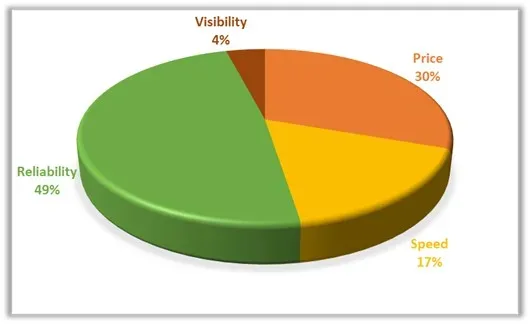Shipping Priorities: Insights from a Survey
As the economy evolves, so do the preferences and priorities of consumers when it comes to shipping small parcel shipments. ShipMatrix recently asked a question to delve into the minds of consumers and understand what truly matters to them in the realm of shipping. The results shed light on the shifting dynamics of consumer preferences and how businesses can adapt to meet these changing demands. For instance, consumers now exhibit less stringent demands for a two-day delivery model. They are increasingly open to a 3–5-day delivery window, provided it is clearly communicated in advance and remains a cost-effective option.
The Results: Unveiling Consumer Priorities
We asked respondents to identify what they deemed most important when shipping small parcel shipments. The options provided were Price, Speed, Reliability, and Visibility. Here's a breakdown of the responses:
- Price - 30%
- Speed - 17%
- Reliability - 48%
- Visibility - 4%

Reliability Takes the Lead
A key insight from the survey is the considerable importance consumers assign to reliability. Nearly half of the respondents prioritize the assurance that their shipments will reach their destinations without any hiccups. This signals a fundamental shift in consumer expectations, suggesting that businesses need to focus on delivering a consistent and dependable shipping experience to gain and retain customer trust.
A Balancing Act: Price and Speed
While reliability tops the list, consumers still consider Price and Speed as important factors, though to a lesser extent. The balance between these two factors is delicate, with businesses needing to strike the right equilibrium to satisfy diverse customer segments. Some customers may prioritize budget-friendly options, while others might be willing to pay a premium for faster delivery.
The Value of Visibility
Although Visibility garnered the lowest percentage of responses, it's not a factor to be overlooked. In today's digital age, consumers are accustomed to tracking their packages in real-time. Providing transparency and frequent updates can enhance the overall customer experience and alleviate anxieties related to shipping delays.
Adapting to Changing Consumer Landscape
These survey results offer crucial insights for businesses aiming to succeed in the ever-evolving landscape of shipping and logistics. Here's how businesses can respond to these changing consumer preferences:
1. Prioritize Reliability
Given the high importance consumers place on reliability, businesses must invest in robust shipping processes and logistics. Implementing advanced tracking systems, effective communication, and proactive issue resolution can significantly enhance the perceived reliability of a shipping service.
2. Flexible Pricing and Speed Options
Offering tiered pricing and delivery speed options allows businesses to cater to various customer preferences. By providing both cost-effective and expedited choices, businesses can capture a wider audience.
3. Enhance Visibility
While visibility might not be the top priority, it's a critical aspect of the customer journey. Implementing user-friendly tracking interfaces and proactive notifications can add value to the shipping experience.
Customer-Centric Approach
The survey underscores the importance of understanding and adapting to customer needs. Businesses that actively listen to their customers' preferences and feedback can tailor their shipping strategies to align with these expectations.
Summary
Reliability is king, with nearly half of respondents prioritizing seamless deliveries. Businesses must balance price and speed to meet varied customer preferences. While visibility is less important, it shouldn't be overlooked in the digital age. To succeed, businesses should prioritize reliability through advanced tracking and communication. They should also offer flexible pricing, enhance visibility, and maintain a customer-centric approach. By adapting to these insights, businesses can thrive in the face of changing consumer demands and build lasting connections with their consumers.




